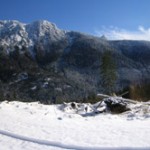General Policies
The Research Forest’s primary objective is to support research in the field of Forestry and allied sciences. Therefore, any human induced activity that negatively affects the natural environment will not be permitted. Prior to allowing the preliminary scout access to the Research Forest, they should be familiar with the scenic requirements that the film is trying to portray. That way, it will make it easier for the Research Forest staff to direct the scout to a more suitable location in less time. We would appreciate 24 hours notice prior to your arrival to allow for rescheduling of daily activities if you require any on-site assistance.
Some items are not permitted within the Research Forest in order to preserve the research environment. These items include gas powered boats on lakes and the import of non-Research Forest flora. We also would prefer minimal movement of flora within the forest.
There are a number of rules that the general public must follow when using the Research Forest, such as no camping, dogs, horses, fires, smoking, fishing, and bikes. Please consult with the Research Forest prior to doing any of the following listed above. Consultation should also occur before explosions, domestic animals, and fire are used during filming. We need to also know your intentions when working around lakes, rivers and streams and whether or not you need to remove any trees and brush on set. During the summer when using generators, especially during high fire hazard ratings, fire fighting equipment must be on location and ready to use if needed. Finally, there is also the possibility that a wear and tear charge to roads may apply if damage is excessive. Please send any questions and requests regarding scouting and/or filming to Ionut Aron.
Infrastructure of the Research Forest
The infrastructure of the Research Forest is well established. Located on the property are an office and work shop and an outdoor research and education centre which caters to groups of up to 150 people. Any items, such as tractors, chainsaws and brushsaws, which may be needed for moving equipment or removing unnecessary brush, can be provided at a standard hourly rate. The roads are typical gravel roads. There are over 120 km of roadway that needs continual maintenance for access by researchers. As finances allow, we try to keep them in a suitable condition to allow cars to travel on them.
Active Logging Operations
The Research Forest prescribes to all the conventional silvicultural systems – clearcutting, shelterwood, seed tree and selection – in order to enhance stand diversity and meet management objectives. Having all the silvicultural systems present in the Forest is beneficial for filming as each system provides a number of different stand conditions to suit story setting requirements or lighting conditions. The Research Forest is self-funded. As such, harvesting occurs annually on a sustainable yield basis to support the infrastructure and to pay for the creation of research and educational opportunities.
Benefits of Filming at the UBC Malcolm Knapp Research Forest
There are many reasons why it is beneficial for film companies to work on site within the UBC Malcolm Knapp Research Forest. First, a staff member is available for consultation with film crew whenever necessary. Second, there are no public vehicles allowed in the forest and public transportation is limited only to walking. Access by vehicle within the Research Forest is restricted to staff, researchers and Loon Lake Research and Education Centre users only. Therefore, filming can be done without having any space conflicts with the general public. And finally, we are willing to work through any problems that may develop, and provide solutions, to prevent any deleterious impacts from occurring to our research environment.
Suitable Filming Locations
Lakes and Docks – There are a total of eighteen lakes within the Research Forest, of varying sizes, access, and development. Four of the lakes within the Research Forest have docks on them (Marion, Loon, Placid, Gwendoline) as does Pitt Lake to the North of the Research Forest.
Log Cabin Settings – An outdoor research and education centre is located at Loon Lake where there is enough room to sleep approx. 180 people. The location has log cabins, electricity, plumbing and running water.
Vista Backdrops – There are a number of locations that provide scenic backdrops of the Golden Ears, Pitt Polder near Pitt Lake, the valley towards Vancouver, and towering old growth forests.
Helicopter pads – There are six helicopter pads located within the Forest with different backdrops and scenic values.
Gravel Pits – There are two gravel pits within the Forest. They are multi-leveled and can be used in various ways to create small set designs or as is.
There are a multitude of additional filming locations within the Research Forest that can be enhanced to suit your needs.
Should you have any questions, or to schedule a visit, please contact Ionut Aron.
